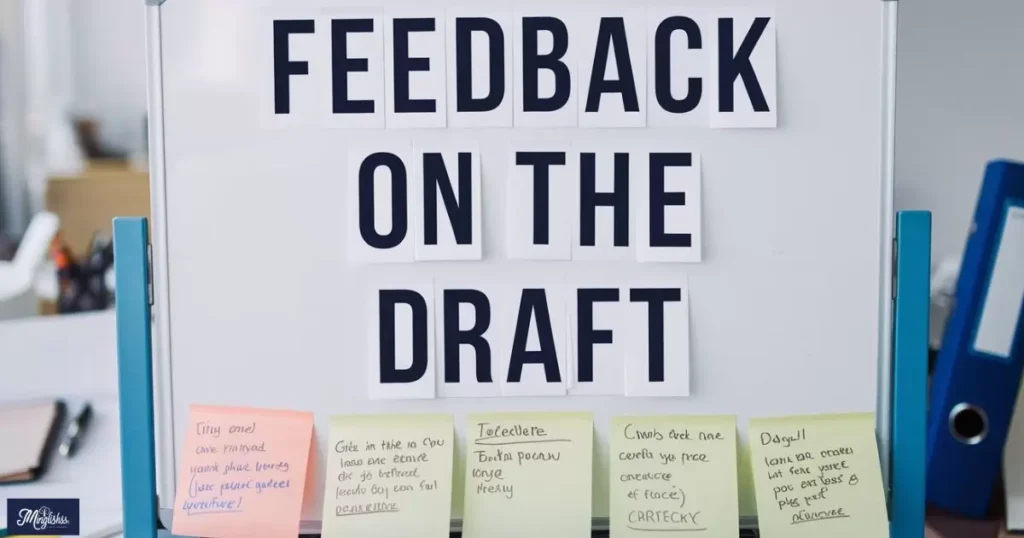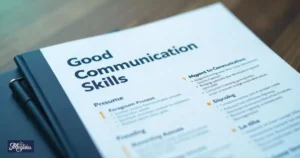“We value your insights and welcome your feedback to enhance our communication strategies.”
Effective communication is crucial in any professional setting, and seeking input is a key component of fostering a collaborative environment. When you need to solicit feedback or gather opinions formally, it’s essential to phrase your requests in a way that encourages engagement while maintaining professionalism. This blog will explore various formal methods to seek input, ensuring that your communication is clear, respectful, and conducive to constructive dialogue.
When you approach someone for input, how you frame your request can significantly impact the quality and relevance of the feedback you receive. Using formal language not only demonstrates respect but also underscores the importance of the input you are seeking. By employing appropriate and polished expressions, you can enhance the effectiveness of your communication and achieve more valuable insights.
Understanding the right way to ask for input involves more than just asking questions; it’s about creating an environment where contributors feel valued and heard. This guide will provide you with various formal expressions and scenarios to help you effectively seek input and enhance your communication processes.
25 Formal Ways to Seek Input Enhancing Communication
1. “We would greatly appreciate your feedback on the recent project to help us improve our approach.”
Scenario: Requesting feedback after completing a project.
Explanation: This phrasing shows appreciation for the recipient’s input and indicates that their feedback will be used for improvement.
Additional Tip: Use this approach when you want to convey that the feedback is integral to the improvement process.
2. “Your insights on the proposed strategy would be invaluable to us. Could you please provide your thoughts?”
Scenario: Seeking feedback on a new strategy proposal.
Explanation: Emphasizes the value of the recipient’s insights and formally requests their input.
Additional Tip: Ideal for situations where strategic input is crucial and highly valued.
3. “We invite you to share your thoughts on the current communication plan to ensure its effectiveness.”
Scenario: Requesting input on a communication plan.
Explanation: Invites the recipient to contribute their thoughts, focusing on the effectiveness of the plan.
Additional Tip: Use this when you need to ensure that the communication plan meets its objectives and involves key stakeholders.
4. “Please provide your feedback on the recent changes to our procedures at your earliest convenience.”
Scenario: Seeking feedback on procedural changes.
Explanation: Requests feedback in a formal manner, specifying the need for a timely response.
Additional Tip: Suitable when prompt feedback is needed to address procedural adjustments quickly.
5. “We would value your expert opinion on the proposed changes to our policy framework.”
Scenario: Requesting expert feedback on policy changes.
Explanation: Highlights the recipient’s expertise and requests their opinion on specific changes.
Additional Tip: Use this when the feedback requires specialized knowledge or insight.
6. “Could you please review the attached document and provide your input on its contents?”
Scenario: Asking for input on a document or report.
Explanation: Formally requests a review and input on specific content.
Additional Tip: Ideal for situations where detailed feedback on a document is required.
7. “We seek your feedback on the draft proposal to ensure it aligns with our objectives and standards.”

Scenario: Requesting feedback on a draft proposal.
Explanation: Emphasizes alignment with objectives and standards, indicating the importance of the feedback.
Additional Tip: Use this approach when ensuring that the proposal meets key goals and quality standards is critical.
8. “Your feedback on the recent survey results would be greatly appreciated to guide our next steps.”
Scenario: Requesting input on survey results.
Explanation: Shows appreciation and indicates that the feedback will guide future actions.
Additional Tip: Suitable for situations where survey results need to be analyzed and acted upon.
9. “We are interested in your perspective on the effectiveness of our current marketing strategies.”
Scenario: Seeking input on marketing strategies.
Explanation: Invites the recipient to share their perspective on specific strategies.
Additional Tip: Use this when you need to assess the effectiveness of marketing efforts.
10. “Please share your insights on the proposed changes to enhance our operational efficiency.”
Scenario: Requesting feedback on operational changes.
Explanation: Requests insights on improving operational efficiency.
Additional Tip: Ideal for situations where operational improvements are being considered.
11. “We would be grateful for your suggestions on how to improve our customer service practices.”
Scenario: Seeking suggestions for improving customer service.
Explanation: Formally requests suggestions to enhance customer service practices.
Additional Tip: Use this when seeking actionable suggestions for improving service quality.
12. “Could you provide us with your feedback on the effectiveness of our recent training sessions?”
Scenario: Asking for feedback on training sessions.
Explanation: Requests feedback on the effectiveness of training.
Additional Tip: Ideal for assessing and improving training programs.
13. “We are eager to hear your thoughts on the new product features we are considering.”
Scenario: Requesting feedback on product features.
Explanation: Shows eagerness to hear thoughts on potential product features.
Additional Tip: Use this when feedback on new product ideas is needed.
Professional Ways to Say “Please Feel Free”
14. “Your feedback on our annual report would be appreciated to ensure it meets our stakeholders’ expectations.”
Scenario: Seeking feedback on an annual report.
Explanation: Requests feedback to ensure the report meets stakeholder expectations.
Additional Tip: Suitable for finalizing reports that will be reviewed by stakeholders.
15. “Please provide your input on the proposed budget allocations for the upcoming fiscal year.”
Scenario: Requesting input on budget allocations.
Explanation: Requests input on budget decisions for the next fiscal year.
Additional Tip: Ideal for financial planning and decision-making processes.
16. “We would appreciate your review of the attached proposal to ensure it meets all regulatory requirements.”
Scenario: Seeking input on regulatory compliance of a proposal.
Explanation: Requests a review to ensure compliance with regulations.
Additional Tip: Use this when regulatory adherence is a critical aspect of the proposal.
17. “Could you kindly review the proposed changes to our product line and share your recommendations?”
Scenario: Requesting recommendations on product line changes.
Explanation: Formally requests a review and recommendations on product modifications.
Additional Tip: Suitable for product development and strategy adjustments.
18. “We invite you to share your views on the recent changes to our employee benefits program.”
Scenario: Seeking input on employee benefits.
Explanation: Requests feedback on changes to employee benefits.
Additional Tip: Ideal for ensuring that employee benefits meet staff needs and expectations.
19. “Please provide your thoughts on the newly introduced communication tools to enhance team collaboration.”
Scenario: Requesting feedback on new communication tools.
Explanation: Requests thoughts on tools intended to improve collaboration.
Additional Tip: Use this when assessing the effectiveness of new tools or technologies.
20. “We are interested in your feedback on the implementation of our new project management software.”
Scenario: Seeking feedback on project management software.
Explanation: Requests feedback on the implementation of software.
Additional Tip: Ideal for evaluating the success of new software implementations.
21. “We would greatly value your input on the current strategic initiatives to align with our long-term goals.”
Scenario: Requesting input on strategic initiatives.
Explanation: Emphasizes alignment with long-term goals and values the recipient’s input.
Additional Tip: Use this approach for high-level strategic planning and alignment.
22. “Could you please share your observations on the recent changes in our customer engagement strategies?”

Scenario: Asking for observations on customer engagement strategies.
Explanation: Requests observations on changes made to engage customers.
Additional Tip: Suitable for refining customer engagement approaches.
23. “We would appreciate your expert opinion on the proposed enhancements to our service delivery model.”
Scenario: Seeking expert opinion on service delivery enhancements.
Explanation: Requests an expert’s opinion on improving the service delivery model.
Additional Tip: Ideal for consulting experts on service improvement.
24. “Please provide your feedback on the attached proposal to help us ensure its success.”
Scenario: Requesting feedback on a proposal for ensuring success.
Explanation: Formally requests feedback to enhance the chances of proposal success.
Additional Tip: Use this when feedback is crucial for refining and finalizing proposals.
25. “We seek your insights on the recent adjustments to our operational procedures to optimize efficiency.”
Scenario: Seeking insights on adjustments to operational procedures.
Explanation: Requests insights to improve operational efficiency.
Additional Tip: Ideal for optimizing processes and procedures.
Pros and Cons Table
| Pros | Cons |
| Encourages constructive feedback: Formal requests invite detailed and thoughtful responses. | May seem impersonal: Formal language might lack warmth and personal touch. |
| Enhances clarity: Clear and formal requests reduce ambiguity and miscommunication. | Requires careful phrasing: Must be worded correctly to avoid misunderstandings. |
| Builds professional rapport: Shows respect for the recipient’s expertise and opinion. | Can be perceived as overly formal: May not suit all organizational cultures or contexts. |
| Facilitates targeted input: Focused questions lead to more relevant and useful feedback. | Feedback might be less candid: Formality might discourage honest or open responses. |
| Demonstrates respect and seriousness: Shows that you value the recipient’s input. | May delay responses: Formal requests might take longer to address. |
Conclusion
Seeking input in a formal manner is crucial for maintaining professionalism and ensuring that communication is effective and respectful. By using well-structured and polite expressions, you enhance the likelihood of receiving valuable feedback and foster a collaborative environment. This approach not only helps in gathering useful insights but also demonstrates respect for the opinions and expertise of others, ultimately leading to more informed decisions and improved communication strategies.
Answer to key Question
Q1: Why should I use formal language to seek input? A1: Formal language shows respect and seriousness, which can lead to more thoughtful and valuable feedback.
Q2: How can I ensure my request for input is clear? A2: Use specific and unambiguous language, and provide context to guide the recipient in giving relevant feedback.
Q3: Is formal language always necessary when seeking input? A3: It depends on the context. For professional or high-stakes situations, formality is often preferred, while informal settings may allow for a more casual approach.
Q4: How can I balance formality with approachability? A4: While being formal, ensure your language is courteous and open, inviting the recipient to share their thoughts comfortably.
Q5: What if I receive feedback that is not actionable? A5: Follow up with clarifying questions to gain more detailed insights and ensure the feedback is useful for your needs.

Hi, I’m Zadie Smith: I’m dedicated to helping others master English through practical tips. I enjoy making complex ideas simple and accessible for everyone.










